Text

Colonel Allison Maverick of First Cavalry and the Violet Crown. Defender of Austin, warrior of the faith, and baddass cowgirl. A post-post-apocalyptic gal, since medieval cowgirls is a concept that kicks fucking ass
#worldbuilding#americana#digital art#after the end#cowgirl#post apocalyptic#post post apocalypse#medieval#imagine how much cooler Texas would be if they regressed to the early medieval era’s tech
14 notes
·
View notes
Text
Anthropologists believe that Americans in the 20th and 21st Centuries kept collections of hagiographies of their saints called history textbooks. [1] Some scholars speculate that Benjamin Franklin was a trickster god in their pantheon which descends from similar figures in earlier religious practices. [2]
2K notes
·
View notes
Text


Columbia x Lady Liberty, the Adoptive Moms of America
72 notes
·
View notes
Text

Yeah so uh I’ve done some more Jesi, thoight you’d all like them together :)
#digital art#worldbuilding#after the end#ate#christian mythology#ck3#oc artwork#jesus#christo pagan#abrahamic religions#abrahamic mythology
42 notes
·
View notes
Text
Fun fact, it’s actually a misconception to call the powerful and divine Kennedy by the name JFK.
His actual name was John Phoebus (the Shining, Pure or Bright) Kennedy. It was the result of mishearing Kennedy’s epithet that led to the false usage of “F” in Kennedy Delphinius’s abbreviated name.
9 notes
·
View notes
Text
Spectember D3: Atavism
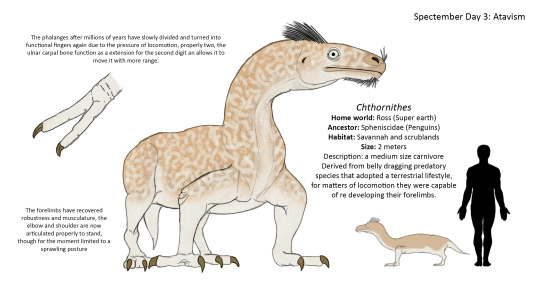
The colony planet "Ross" was a very cold super earth when humans arrived, served as a early settlement for the human interstellar expansion and then as a sanctuary of earth fauna when this was facing an ecological crisis, Ross was populated by different species of penguins that thrived on the conditions, so well that when humans finally disappeared, they kept evolving. Dozens of millions of years the semiaquatic birds managed to conquer the land, establishing as the dominant terrestrial tetrapods, as this world started to get warmer and warmer, and it was until 100 million years something more peculiar happened, something brough back of the ancestry of birds much far behind of dinosaurs, when their ancestors were just semi erect archosauromorphs.
The Chthornithes is sort of return of the “reptilian” condition, resemble little of the semi aquatic creatures that came from, its result of the dry warm climate that have slowly changed its metabolism to an ectotherm, this is a descendant of a branch of belly dragging terrestrial carnivores that properly modified its wings into functional arms, with didactyl and clawed digits that were slowly reforming as they needed proper ways to grasp on the ground, useful for movement now as it can stand on its forelimbs, the skin is covered predominantly of scales, with partial filament like feathers at the top of its neck and head which are remains of their far ancestral feathered forms. These minuscule pebble-like scales, even though looks similar to the earth squamates, aren’t originated similar but derived from feathers adopting something like the feet scales. The head is shaped differently, the beak has shortened, now the lacrimal extend further and leaves the nasal cavity in front making some resemblance to the head of an early theropod, with some rudimentary long blade shaped teeth that allows it to eat small invertebrates and small bird species.
This animal inhabits the large landmass of Ross that formed over the last 50 million years in the equatorial regions, especially in the savannah and scrublands, alongside other peculiar forms of penguin descendants that resemble still birds in many degrees this bizarre animal is a newcomer that could eventually change the landscape of this super earth from bird shaped dominant megafauna to something totally different, if it is capable to survive and leave descendance.
Derived from belly dragging predatory species that adopted a terrestrial lifestyle, for matters of locomotion they were capable of redeveloping their forelimbs, as well for the climate and metabolism have lost most of its feathers that have turned into scales.
The phalanges after millions of years have slowly divided and developed again functional fingers again due to the pressure of locomotion, properly only two with the second using the ulnar carpal bone as a extension for the second digit that allows it to move it with more range. The forelimbs have recovered robustness and musculature, the elbow and shoulder are now articulated properly to stand, though for the moment limited to a semi-sprawled posture.
---------------------------------
This is sort of a old continuation of a piece I made years ago about a terraformed sanctuary world with penguins which it continues the peculiar adaptation these had without any competition apart of themselves

#speculative evolution#future evolution#seed world#terraformed world#penguin#quadrupedal bird#spectember
89 notes
·
View notes
Text
A Brief History of Flamingos
People wanted it so here it is, a brief rundown of flamingos throughout prehistory, which is essentially a brief summary of extinct flamingo species that I worked on for Wikipedia.
Because of this, I'll stick to the two main famillies, the Palaeolodidae ("swimming flamingos") and Phoenicopteridae (true flamingos) and leave aside the misc. early forms we don't know are actually related or not.
Palaelodidae
Palaelodids, occasionally referred to as "swimming flamingos" are an interesting and surprisingly long lasting group, containing 3 genera, 10 species and ranging from the Oligocene to the Pleistocene across all continents bar Africa and Antarctica.
The oldest palaelodid is Adelalopus hoogbutseliensis from the Early Oligocene of Belgium. Not much to be said other than that its name is an anagram of Palaelodus.
Palaelodus is the most widespread of the genera in the family, with the type species being Palaelodus ambiguus from the Oligocene and Miocene of Europe. I did actually make a whole post about the genus before here. Anyways, P. ambiguus is the best known species thanks to the ample material collected at Saint-Gérand-le-Puy, France. Remains were also found in Germany and maybe Brazil?
Brazil is interesting, because already by the Oligocene palaelodids were nearly cosmopolitan. Two other species, Palaelodus pledgei and Palaelodus wilsoni, have been recovered from the Oligocene to Miocene of Australia, half a world away from P. ambiguus. P. pledgei is the smallest known species of Palaelodus.
During the early Miocene we also get Palaelodus aotearoa, from New Zealand, and from the middle Miocene Palaelodus kurochkini from Mongolia. The later of the two may in fact be its own genus, but for now its deemed Palaelodus.
Generally, Palaelodus is less specialised than flamingos, though living in brackish waters and feeding on small aquatic insects, they didn't yet have the same suffisticated filter feeding bill as todays flamingos. Whats debated is how they moved. Some suggest wading, others diving and again others propose the idea that they may have been swimmers.
There is one more note on this group, which is that there are some remains assigned to P. wilsoni that appear to have been Pleistocene in age? Obviously this would be a massive deal, but it has also been suggested that this could be a new species given the time gap or a whole new genus. Still, palaelodid remains from the Pleistocene are still incredible.
Palaelodus by Alphinyx and Tom Simpson


The last member of the Palaelodidae is Megapaloelodus. Yes they misspelled Palaelodus in the genus name. The definition of this form is kinda vague and mostly based on size, which is why there's so many issues around Megapaloelodus goliath. You see it was initially described based on its size, but when larger remains of Megapaloelodus were found it was transferred to that genus. However, all other Megapaloelodus species are from the Americas, so thats kinda odd, although of course not a dealbreaker. Still, future research might change things up here.
While Megapaloelodus goliath was contemporary and found at the same place as Palaelodus ambiguus, all others are found in Miocene to Pliocene deposits of America.
Megapaloelodus connectens is the type species and known from the Miocene of South Dakota and California.
Megapaloelodus peiranoi may be the basalmost species and was discovered in Miocene deposits of Argentina.
Finally, we got Megapaloelodus opsigonus from Oregon and possibly Baja California. As this is the youngest species, from the Pliocene, its name means "born in a later age".
Megapaloelodus by Joschua Knüppe (with Argentavis) and Scott Reid

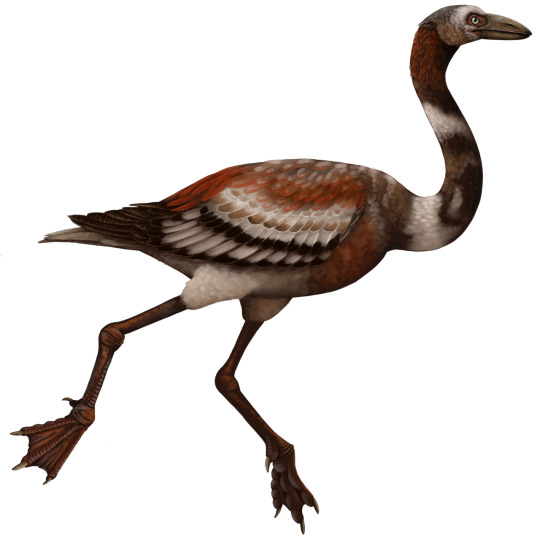
Which actually wraps up palaelodids. Yeah the majority of studies are focused on palaelodids, no surprise given its the only one with really good remains. But based on said animal, its a fascinating group.
This means we can move on to true flamingos, members of the family Phoenicopteridae. I hope you like that name btw, because goddamn "Phoenico" is an overused prefix for these animals to a ridiculous degree. Even I struggled keeping up.
Just to set the stage, lets establish the modern flamingos, split into two to three genera. There is the Lesser Flamingo (Phoeniconaias minor), the only extant member of its genus and native to Africa and Asia. There are two species of Phoenicoparrus, the Andean and Jame's flamingos (Phoenicoparrus andinus and Phoenicoparrus jamesi respectively), both endemic to South America. And then there's the three species of Phoenicopterus. The incredibly whidespread Greater Flamingo (Phoenicopterus roseus), the American Flamingo (Phoenicopterus ruber) and the Chilean Flamingo (Phoenicopterus chilensis). As if the Greater and American flamingos didn't already have latin names way too similar, they were also synonyms for a while so thats fun when they get brought up in old papers.
Chart of living flamingos by Mr. Gharial

Anyways, lets reset to the Oligocene and do this semi-chronologically as before. And yes, Oligocene. Because contrary to what you might think, palaelodids, as we currently think of them as, aren't the ancestors to flamingos and more a really weird sister group that appeared from the same common ancestor aroundt he same time.
Thankfully, we get to start with something fun and not confusing, Harrisonavis croizeti. Another one I did actually cover in detail on Tumblr right here. The short of it is that Harrisonavis already bears the hallmarks of modern flamingos, possessing that classic curved bill and certainly doing some filter feeding already. And if you paid attention you might recognize where its from. Saint-Gérand-le-Puy, France. Yup, this guy coexisted with Palaelodus and Megapaloelodus. Must have been a fascinating place.
Harrisonavis and Palaelodus by Joschua Knüppe

Of course this being a well known form, we gotta follow it up with something bad. Elornis is, simply put, a mess. We aren't even super sure if its a flamingo or not and its history is convoluted. All we can say for sure is that it lived during the late Oligocene in France.
Like palaelodids, true flamingos seem to have dispersed rapidly, as our next entry managed to reach Australia by the late Oligocene. Phoeniconotius eyerensis, I repeat that one, PhoenicoNOTIUS (you see what I mean with things getting confusing?) is a genus from the Lake Eyre Basin of South Australia. It was a comparably robust animal, much more massive than other flamingos and perhaps more of a wader than a swimmer, staying away from deeper waters?
Same time same place we got Phoenicopterus novaehollandiae. PhoenicoPTERUS, as in the same genus as American and Greater flamingos. Now this guy sticks mostly to the same stuff as its relatives, thus differing clearly from Phoeniconotius.
Phoeniconotius (foreground), Phoenicopterus novaehollandiae (?, middle) and palaeolids (background) by Frank Knight, Phoeniconotius by Anne Musser


We can now move into the Miocene. We get a brief break from Phoenico names courtesy of Leakeyornis aethiopicus from Kenya. Tho its not super well preserved, its among the few fossil flamingos with known skull remains, so thats gotta count for something.
Skeletal by me, art by Joschua Knüppe
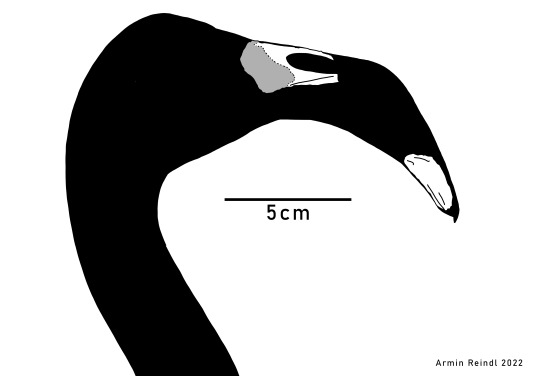
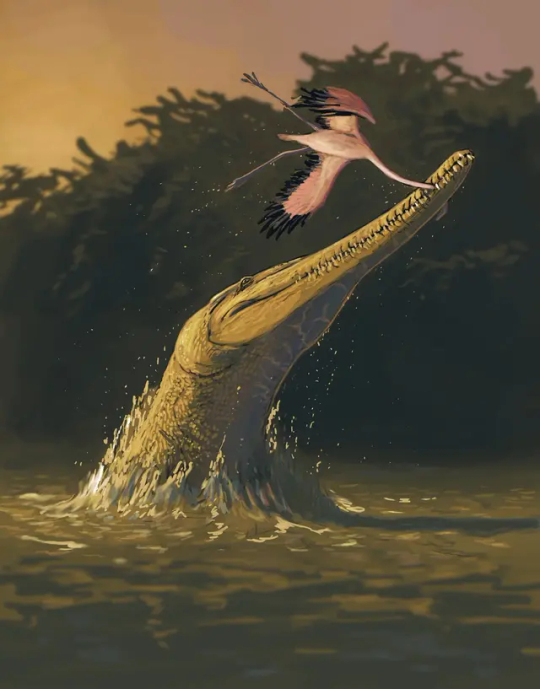
Also during the Miocene, we get the appearance of the genus Phoeniconaias (PhoenicoNAIAS) thanks to Phoeniconaias siamensis. A small species, only slightly larger than today's Lesser Flamingo, its remains are exclusively known from the Mae Long Reservoir in northern Thailand.
Fossil material of P. siamensis alongside a Lesser Flamingo via เบิร์ดโบราณ - Ancient bird on Facebook
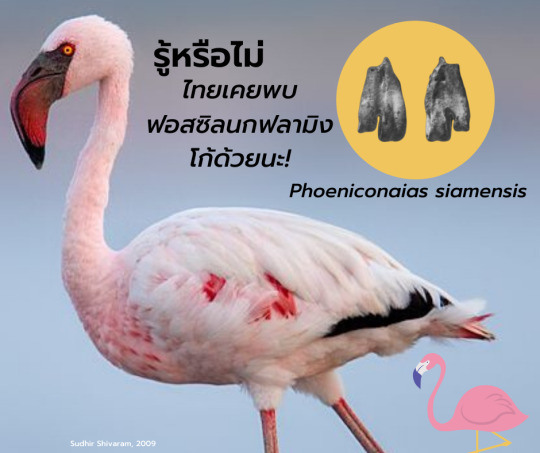
And already we find ourselves in the Pliocene. Oh how time flies. Lets wrap up known fossil species of Phoeniconaias then while we're at it. Phoeniconaias proeses is a species from Australia. Unlike our friend from Thailand, this one is actually smaller than its modern relative. It also coexisted with two other flamingos. Fossils from the region have been assigned to the Greater Flamingo and one other form we'll cover next.
Xenorhynchopsis. Our last truly original name. Xenorhynchopsis minor is the older of the two, Pliocene in age and the species I just alluded to earlier. The genus then went on to continue into the Pleistocene via Xenorhynchopsis tibialis. Neither is especially well known and both had been named by de Vis, who while no doubt an important contributor to Australian paleontology also had plenty of flaws I'll discuss soon with my next post on mekosuchines. Anyways, Xenorhynchopsis has a cool name, a confusing history (they were described as storks) and likely died out when the inland waterways of Australia dried up.
Its all downhill from here folks. It's all PhoenicoPTERUS from now on and none of them are especially good. Lets rewind to the Pliocene to cover them properly.
We got Phoenicopterus floridanus from the early Pliocene of, who guessed it, Florida. It may have also inhabited North Carolina.
Phoenicopterus stocki, or Stock's Flamingo, lived during the middle Pliocene in Mexico. Tho not well described, we got juvenile remains too, young individuals that were not yet capable of flight.
Finally we got two Pleistocene species.
Phoenicopterus minutus from California, specifically Lake Manix. Lake Manix also yielded fossils tentatively assigned to the other Pleistocene fossil species.
Phoenicopterus copei. While fossils of P. minutus are currently exclusive to Lake Manix, P. copei was more widespread, ranging from Mexico in the south to Oregon in the north as well as California in the west and Florida in the east. Where it coexisted with other flamingos, like P. minutus and American flamingos, it would have been the larger species.
And thats it. All the fossil flamingos of the Palaelodidae and Phoenicopteridae. Alas, bird fossils preserve notoriously poorly and though stuff like the ends of tibiatarsi and tarsometatarsi are diagnostic, they aren't super helpful to making them sound interesting to the average joe. So sorry if this whole post is a little dry in spots.
#palaelodidae#phoenicopteridae#palaelodus#megapaloelodus#adelolepus#leakeyornis#harrisonavis#phoenicopterus#elornis#phoenicoparrus#paleoblr
158 notes
·
View notes
Text
Dissertation on Inkling spiritual beliefs please.
Facts:
Inklings and Simon Belmont both appear in Smash Bros.
Respawn points are canonically a real technology in the Splatoon universe, and it's impossible for an Inkling to permanently die while they're synchronised with one.
Simon Belmont is canonically Christian.
This information in mind, I want you to imagine Simon Belmont trying to explain the miracle of the Resurrection to an Inkling.
8K notes
·
View notes
Text

Just your average Cyberede Medieval-Chaos Magick-Wicca-Hacker fella from the Golden State with the goal of magickally hacking reality
I thinking of naming her Emrys DeDauce, any suggestions?
13 notes
·
View notes
Text
I am taking everyone who made a poll to gauge the True Percentage of Queers on Tumblr and putting them through a statistics course
44K notes
·
View notes
Text
Stitch’s Alien to Dog transition timeline
Yeah you're right. It WOULD be pretty fucked up if you were a swan but you were raised by ducks and you grew up never seeing another swan or even knowing that such a thing as a swan even existed so you just thought you were a duck with something super wrong with it.
323K notes
·
View notes
Text
🌟☘️✨**LIFEHACK!<3**✨☘️🌟
Don’t<3 ❌
Mow<3🔪🌿
Your<3👉
Wifi cables<3 ❌🔪🪢❌
I FUCJIKG HATW GRASS<3❌🌿❌
4 notes
·
View notes
Text

:) my friend Firstname de Surname wrote this not me but I drew the lanky tortoise
**Tortoise Lore**
"The Ebrohean Royal Tortoise, known also as the Giant Feathered Tortoise, is a species unique to the Royal Isle and, in many ways, representative of Ebrohe itself. It is native to southwestern Ebrohe, but has been introduced across the entire island and to some of the further isles in the Sea of Kings. It has long been revered in Ebrohe due to its longevity, pleasant temperament, and unique appearance.
It can grow to a height of five feet and a length of six, and is covered in a coat of soft, downy feathers. Upon its head and tail grow bright plumage often depicted in Ebrohean art and heraldry. It feeds mostly upon fruit and foliage, making it an ideal inhabitant of royal gardens. It is said to drink no water, subsisting only on the dew and juices of its diet. It is nearly deaf, but generally friendly and gregarious. Even wild Royal Tortoises tolerate, and seem to enjoy, the presence of humans. Males tend to be more solitary in their later years, while females and young males congregate in herds. Old male tortoises are usually referred to as ‘Crown Tortoises’, females as ‘Princess Tortoises’ and young males as ‘Prince Tortoises’.
I don’t think he’s on Tumblr, if you are please whack me.
3 notes
·
View notes
Text

*eyes squint*
I feel like we all don't appreciate the fact mosasaurs were lizards enough.
Like, they're the only prehistoric animal group that people accidentally call "giant lizards" and are right about it.
It's a beautiful broken-clock-correct-twice-a-day scenario.
5K notes
·
View notes
Text
“The pro-locomotion Deep State will try to tell you that it’s somehow ‘backwards’ and ‘limiting’ to stay rooted in a single position. Of course, these ‘Vertebrates’, as they call themselves, are just immature hippies who don’t understand basic biology and refuse to grow up.” - Average Tunicate
#tunicates trust Turning Point Chordata#tunicate#evolution#evolutionary biology#chordata#vertebrates#all ‘skull havers’ are just insolent children who need to respect their elders
16 notes
·
View notes
Text
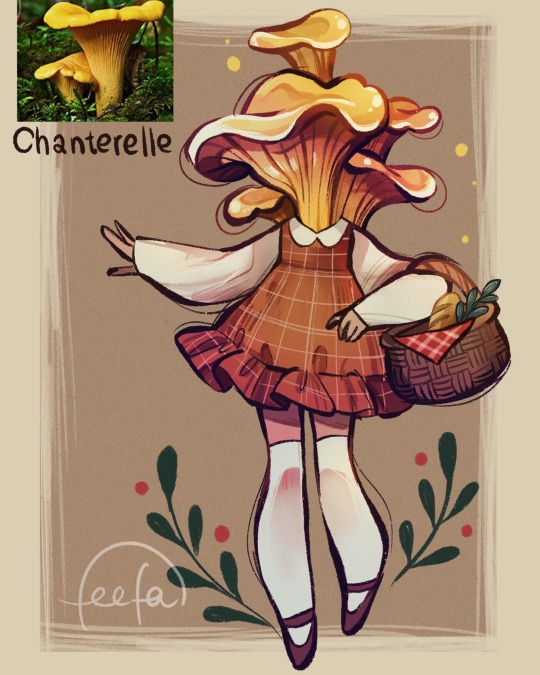
8K notes
·
View notes
